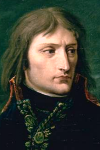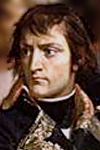In March 1796, the Directory, dominated by Paul
Barras, appointed Napoleon Bonaparte Commander in chief of the
Army of Italy. Bonaparte married Josephine
de Beauharnais, a Creole widow of a General with two young children,
and left for the army. His first speech to his troops, in Nice, revealed
his exceptional qualities as a leader: Soldiers, you are naked,
malnourished... I want to lead you into the most fertile plains in
the world
.
The Italian Campaign began with the arrival of Napoleon in Menton, near Monaco, on April 2nd, 1796. On the 10th he went on the offensive against the Austrian army. Victories started coming quickly: on the 12th at Montenotte, 13th at Millesimo, 15th at Dego, and on the 21st at Mondovi. On 28th, the Sardinians conceded defeat: the envoys of King Victor Amadeus III signed the armistice of Cherasco, a prelude to the Treaty of Paris. While engaging in pursuit of the fleeing Austrians, Napoleon entered Piacenza on May 7th, after having crossed the Po River. Three days later came the victory of Lodi. On the 15th, Bonaparte entered Milan. The requisitions for silver, works of art, and military supplies grew, causing an insurrection of the people of Milan. Punishment was inexorable.
During the following weeks, Bonaparte acted from Milan as a quasi-sovereign.
He concluded treaties with Naples, the Duchy of Parma, and the Holy
See. At the same time, he began the siege of Mantua
On July 26th, however, the new Austrian Commander in chief, Dagobert von Wurmser, went on the offensive. On the 30th, Bonaparte lifted the siege of Mantua and stayed ahead of his opponents who made the mistake of dividing their forces. On August 3rd, André Masséna beat one of their corps at Lonato. On the 5th, another corps suffered defeat in Castiglione. Beaten again on September 8th in Bassano del Grappa, Wurmser took refuge into Mantua.
The Austrians launched a new offensive on November 1st, 1796, under the command of General Josef Alvinczy von Borberek. After some initial successes, Alvinczy was defeated by Napoleon on the 17th at Arcola, after three days of fighting.
A new attempt of the Austrians failed on January 14th, 1797 in Rivoli, Piedmont, and on the 16th in La Favorita. On February 2nd, Wurmser surrendered and evacuated Mantua. Two weeks later, on February 19th, a peace treaty with Pope Pius VI was signed in Tolentino.
In March, Bonaparte proceeded towards Austria. On the 12th, he crossed the Piave River, on the 16th he tumbled the Archduke Charles of Austria in Tagliamento and entered Trieste on the 23rd. A cease-fire concluded on April 7th led to the conference in Leoben between Bonaparte and the Austrian plenipotentiaries, which ended on 18th upon the signature of the peace preliminaries of Leoben.
Napoleon then turned to Venice, which was occupied on May 15th and which, under the treaty signed on the 16th, must provide, in turn, money, ships, paintings and manuscripts, prior to receiving a new administrative structure. The rest of northern Italy was also undergoing a complete reorganization: the Ligurian Republic was proclaimed in Genoa on June 17th, the Cisalpine Republic in Milan on July 9th. All these decisions were made with little consultation with the French government, to which the general even sent a few threatening letters. The same applied to the negotiations launched on May 25th with Austria, that ended on October 17th with the peace treaty of Campo Formio.
Bonaparte, appointed as plenipotentiary representative of the French Republic, then attended the Congress of Rastatt, concerning the occupation of parts of Germany by France. He remained there from November 27th to December 1st, the time to sign an agreement to evacuate Venetian cities by French troops, and the left bank of the Rhine by those of the German Emperor. On December 5th, 1797, Bonaparte returned to Paris.
After having been elected a Member of the Institut de France on January 4th, 1798, Napoleon made an inspection tour on the North Sea shoreline, from Calais to Ostend, and returned on February 23rd with a report that rejected the project of invading England.
Between March and April, the idea of a conquest of Egypt gradually won the French Directory and on May 4th, Napoleon left in person for Toulon to oversee the preparations for such an expedition. The fleet set sail on May 19th, carrying an expeditionary force of 37,000 men. It made a stop-over in Malta (June 10th to 13th) and arrived to the Egyptian coast on July 1st. Bonaparte landed in the middle of the night. The next day, the French entered Alexandria, on the 21st they destroyed the Mamluks in the Battle of the Pyramids, and took Cairo on the 25th.
The situation deteriorated suddenly on the 1st and 2nd of August 1798 with the naval defeat of Abukir (Battle of the Nile): the French became prisoners of their conquest. This did not prevent its organization: the Institute of Egypt was established on August 22nd; on August 29th, the first issue of The Courier of Egypt came out; on September 4th, Bonaparte decided that all the inhabitants of Egypt should wear the tricolor cockade and that the tallest minaret in Cairo – and that of each of the capitals of the provinces – would carry the tricolor flag. On October 21st, however, the population of Cairo revolted: a general and an aide-de-camp to Bonaparte were killed. An immediate and bloody punishment quickly restored calm. On the 30th, Bonaparte found time to inaugurate a garden concert.
In February 1799, General Bonaparte marched onto Syria to meet a Turkish army sent to reclaim Egypt. He left Cairo on the 10th, entered Gaza on the 25th and took Jaffa on March 7th, military feat marred by the massacre of the garrison occurring a few days after. Bonaparte then turned to Acre, which was stubbornly resisting. After defeating a backup army in the battle of Mount Tabor on April 16th, Bonaparte was forced to lift the siege of the city and returned to Jaffa, where he visited his soldiers with the plague (actually his second visit after March 11th). He then gave the signal for retreat and returned to Cairo, where he arrived on June 14th.
A new Turkish army landed by the English fleet on July 17th was defeated on the 25th in Abukir. This was the final victory of Napoleon in Egypt. On August 22nd, he sailed for France and reached Paris on October 16th.



